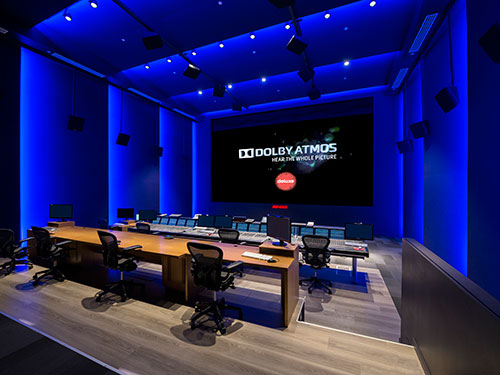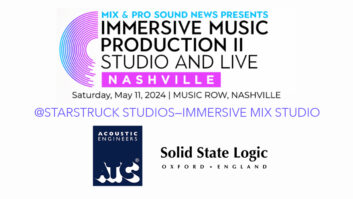
It’s not an uncommon story: A landlord evicts a studio in order to convert a property into condos. But when the studio business is a media giant like Deluxe (Toronto, Ontario), relocating is a massive undertaking.
Deluxe provides a wide variety of audio and visual production, post, distribution and asset-management services. Recent projects include Atom Egoyan’s The Captive, David Cronenberg’s Maps to the Stars, Guillermo del Toro’s Crimson Peak, as well as TV projects The Expanse, Beauty and the Beast, Texas Rising and many others. The company’s facilities were previously situated in a mid-rise landmark building in downtown Toronto. When Deluxe lost its lease, management faced the daunting task of designing, rebuilding and fine-tuning all of its theaters, mix rooms, edit suites and more in about a year-and-a-half, while avoiding downtime that would delay projects.
“They examined more than 30 possible locations, and were led to using the three top floors of an existing office building,” says Martin Pilchner, whose firm, Pilchner Schoustal International, was selected to design the theaters and audio portions of what, all told, would be a 62,000-square-foot project. “They had to work out a deal with the property manager of the building, to lift the roof off a portion of the building to make room for a 22-foot ceiling height required for the main theaters.”
Working closely with Quadrangle (the base building architects) and Deluxe’s technical team (operations VP Nick Iannelli, engineering VP Greg Hull, chief mix engineer Mike Baskerville, and techs Phil Seel and Wayne Palma), Pilchner Schoustal re-created five film-mixing theaters, a Digital Intermediate suite, ADR studio and control room, a screening room (not yet built) and 24 varied edit suites.
“Their workflow and scheduling mean that projects move from space to space, so one of the key issues was, it had to be transparent, moving from room to room,” Pilchner explains. “Our acoustic approach had to make big rooms and small rooms relate the same, so the mixers never have to second-guess anything. We calibrated everything to the scale of each room. The staff will experience the same thing whether they’re in a small room or a large one.” To accomplish this, the same acoustical solutions were used in rooms that needed to translate to each other—generally, diaphragmatic absorption assemblies in the rear of the room, low-frequency trapping in the front, and splayed wall panels/composite absorbers on the side walls.
Pilchner also addressed the need to isolate rooms from each other, and from other floors, without overtaxing the structure. “Every room is constructed as a room-within-a-room,” Pilchner explains. “In a perfect world, they would have six-inch-thick, floated concrete floors, but structural engineering said we couldn’t do that. So we came up with a composite floor built from other materials, including dried sand. It adds weight to the allowed limit, but it helps damp the vibration when you have a limp mass instead of rigid.”
Pilchner also consulted with Dolby on the design of Deluxe’s Mix Theatre 1, which is the first Dolby Atmos mix room in Canada, and coordinated with JBL’s engineering team to upgrade speaker systems in all of the theaters.
“At first they were going to repurpose all of the speaker systems from the old location, but they decided to change to the new JBLs,” Pilchner says. “We tested M2s in their old Theater 1 and thought they weren’t big enough, but then Deluxe worked with JBL engineering to release more power from the speakers, and now they’re just phenomenal.”
Some equipment from the previous location was transferred: The Harrison console was upgraded for Dolby Atmos panning, and a number of workstations came to the new facility, which went online in phases, starting in January 2014. Several theaters were completed by February, and Theater 1 opened in May.
“We did an AES presentation where I showed the response curves in the old Theater 1 compared to the new one, and it was dramatically better,” Pilchner says. “And the old Theater 1 was a famously good-sounding room. Whether it’s the Deluxe staff or outside engineers, everybody loves the sound of these rooms.”







